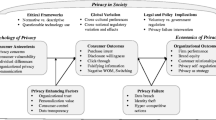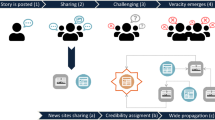Abstract
Online social networks (OSNs) have rapidly become a prominent and widely used service, offering a wealth of personal and sensitive information with significant security and privacy implications. Hence, OSNs are also an important—and popular—subject for research. To perform research based on real-life evidence, however, researchers may need to access OSN data, such as texts and files uploaded by users and connections among users. This raises significant ethical problems. Currently, there are no clear ethical guidelines, and researchers may end up (unintentionally) performing ethically questionable research, sometimes even when more ethical research alternatives exist. For example, several studies have employed “fake identities” to collect data from OSNs, but fake identities may be used for attacks and are considered a security issue. Is it legitimate to use fake identities for studying OSNs or for collecting OSN data for research? We present a taxonomy of the ethical challenges facing researchers of OSNs and compare different approaches. We demonstrate how ethical considerations have been taken into account in previous studies that used fake identities. In addition, several possible approaches are offered to reduce or avoid ethical misconducts. We hope this work will stimulate the development and use of ethical practices and methods in the research of online social networks.


Similar content being viewed by others
Notes
References
Altshuler, Y., Pan, W., & Pentland, A. S. (2012). Trends prediction using social diffusion models. In Social computing, behavioral-cultural modeling and prediction (pp. 97–104). Springer.
Athanasopoulos, E., Makridakis, A., Antonatos, S., Antoniades, D., Ioannidis, S., Anagnostakis, K., et al. (2008). Antisocial networks: Turning a social network into a botnet. Information security (pp. 146–160).
BGU Social Networks Security Research Group. (2013). BGU social networks dataset collection. http://proj.ise.bgu.ac.il/sns/datasets.html.
Boshmaf, Y., Muslukhov, I., Beznosov, K., & Ripeanu, M. (2011). The socialbot network: When bots socialize for fame and money. In Proceedings of the 27th annual computer security applications conference, ACM (pp. 93–102).
CAIDA. (2012). Anonymized Internet Traces 2012 Dataset. http://www.caida.org/data/passive/passive_2012_dataset.xml.
Elishar, A., Fire, M., Kagan, D., & Elovici, Y. (2012). Organizational intrusion: Organization mining using socialbots. In Proceedings of ASE international conference on social informatics, Washington DC, USA, December.
Eynon, R., Fry, J., & Schroeder, R. (2008). The ethics of internet research. In Handbook of online research methods (pp. 23–42). Sage, London.
Eynon, R., Schroeder, R., & Fry, J. (2009). New techniques in online research: Challenges for research ethics. Twenty-First Century Society, 4(2), 187–199.
Eysenbach, G., & Till, J. E. (2001). Ethical issues in qualitative research on internet communities. BMJ, 323(7321), 1103–1105.
Facebook Inc. (2012). Quarterly report pursuant to section 13 or 15(d) of the securities exchange act of 1934. http://www.sec.gov/Archives/edgar/data/1326801/000119312512325997/d371464d10q.htm.
Fire, M., Tenenboim, L., Lesser, O., Puzis, R., Rokach, L., & Elovici, Y. (2011). Link prediction in social networks using computationally efficient topological features. In IEEE third international conference on privacy, security, risk and trust (PASSAT) and IEEE third international conference on social computing (SocialCom) (pp. 73–80). IEEE.
Fire, M., Katz, G., & Elovici, Y. (2012). Strangers intrusion detection-detecting spammers and fake profiles in social networks based on topology anomalies. Human Journal, 1(1), 26–39.
Fire, M., Kagan, D., Elishar, A., & Elovici, Y. (2012a). Social privacy protector—protecting users’ privacy in social networks. In SOTICS 2012, the second international conference on social eco-informatics (pp. 46–50).
Fire, M., Kagan, D., Puzis, R., Rokach, L., & Elovici, Y. (2012b). Data mining opportunities in geosocial networks for improving road safety. In IEEE 27th convention of electrical and electronics engineers in Israel (IEEEI), 2012 (pp. 1–4). IEEE.
Fire, M., Puzis, R., & Elovici, Y. (2013). Organization mining using online social networks. ArXiv preprint arXiv:13033741.
Flicker, S., Haans, D., & Skinner, H. (2004). Ethical dilemmas in research on internet communities. Qualitative Health Research, 14(1), 124–134.
Herzberg, A., & Margulies, R. (2011). Forcing johnny to login safely—long-term user study of forcing and training login mechanisms. In V. Atluri, C. Díaz (Ed.), ESORICS, lecture notes in computer science (vol. 6879, pp. 452–471). Springer, Berlin
Huber, M., Mulazzani, M., Weippl, E., Kitzler, G., & Goluch, S. (2011). Friend-in-the-middle attacks: Exploiting social networking sites for spam. Internet Computing, IEEE, 15(3), 28–34.
Huber, M., Mulazzani, M., Leithner, M., Schrittwieser, S., Wondracek, G., & Weippl, E. (2011a). Social snapshots: Digital forensics for online social networks. In Proceedings of the 27th annual computer security applications conference (pp. 113–122). ACM.
Jernigan, C., & Mistree, B. F. (2009). Gaydar: Facebook friendships expose sexual orientation. First Monday, 14(10).
Kontaxis, G., Polakis, I., Ioannidis, S., & Markatos E. P. (2011). Detecting social network profile cloning. In IEEE international conference on pervasive computing and communications workshops (PERCOM workshops) (pp. 295–300). IEEE
Kunegis, J. (2013). KONECT—the Koblenz Network Collection. http://konect.uni-koblenz.de.
Kwak, H., Lee, C., Park, H., & Moon, S. (2010). What is twitter, a social network or a news media? In Proceedings of the 19th international conference on world wide web (pp. 591–600). ACM.
Liu, Y., Gummadi, K. P., Krishnamurthy, B., & Mislove, A. (2011). Analyzing facebook privacy settings: User expectations vs. reality. In Proceedings of the 2011 ACM SIGCOMM conference on internet measurement conference (pp. 61–70). ACM.
Lucas, R. (2012). Ethics and social eco-informatics. In SOTICS 2012, the second international conference on social eco-informatics (pp. 1–6).
Margulies, R., & Herzberg, A. (2013). Conducting ethical yet realistic usable security studies. In Cyber-security research ethics dialog and strategy workshop (CREDS).
Microsoft-Research. (2013). LETOR: Learning to rank for information retrieval. http://research.microsoft.com/en-us/projects/mslr/.
Mislove, A., Marcon, M., Gummadi, K. P., Druschel, P., & Bhattacharjee, B. (2007). Measurement and analysis of online social networks. In Proceedings of the 7th ACM SIGCOMM conference on Internet measurement (pp. 29–42). ACM.
Mislove, A., Viswanath, B., Gummadi, K. P., & Druschel, P. (2010). You are who you know: Inferring user profiles in online social networks. In Proceedings of the third ACM international conference on web search and data mining (pp. 251–260). ACM.
Narayanan, A., & Shmatikov, V. (2006). How to break anonymity of the netflix prize dataset. ArXiv preprint cs/0610105.
Narayanan, A., Shi, E., & Rubinstein, B. I. (2011). Link prediction by de-anonymization: How we won the kaggle social network challenge. In The 2011 international joint conference on neural networks (IJCNN) (pp. 1825–1834). IEEE.
Pontes, T., Vasconcelos, M. A., Almeida, J. M., Kumaraguru, P., & Almeida, V. (2012). We know where you live: Privacy characterization of foursquare behavior. In UbiComp (pp. 898–905).
Rahman, M. S., Huang, T. K., Madhyastha, H. V., & Faloutsos, M. (2012). Efficient and scalable socware detection in online social networks. In Proceedings of the 21st USENIX conference on Security symposium, USENIX Association (pp. 32–32).
Rosenberg, A. (2010). Virtual world research ethics and the private/public distinction. International Journal of Internet Research Ethics, 3(12), 23–36.
Rydstedt, G., Bursztein, E., Boneh, D., & Jackson, C. (2010). Busting frame busting: a study of clickjacking vulnerabilities at popular sites. In IEEE Oakland Web 2.
Stanford. (2013). Stanford large network dataset collection. http://snap.stanford.edu/data/.
Taylor, C. (2012). Startup claims 80 bots. http://techcrunch.com/2012/07/30/startup-claims-80-of-its-facebook-ad-clicks-are-coming-from-bots/.
Thelwall, M., & Stuart, D. (2006). Web crawling ethics revisited: Cost, privacy, and denial of service. Journal of the American Society for Information Science and Technology, 57(13), 1771–1779.
Wilkinson, D., & Thelwall, M. (2011). Researching personal information on the public web methods and ethics. Social Science Computer Review, 29(4), 387–401.
Zafarani, R., & Liu, H. (2009). Social computing data repository at asu. http://socialcomputing.asu.edu, Arizona State University, School of Computing, Informatics and Decision Systems Engineering.
Zimmer, M. (2010). But the data is already public: On the ethics of research in Facebook. Ethics and Information Technology, 12(4), 313–325.
Author information
Authors and Affiliations
Corresponding author
Additional information
This work was carried out while the H. Shulman was in the Department of Computer Science at Bar Ilan University.
Rights and permissions
About this article
Cite this article
Elovici, Y., Fire, M., Herzberg, A. et al. Ethical Considerations when Employing Fake Identities in Online Social Networks for Research. Sci Eng Ethics 20, 1027–1043 (2014). https://doi.org/10.1007/s11948-013-9473-0
Received:
Accepted:
Published:
Issue Date:
DOI: https://doi.org/10.1007/s11948-013-9473-0




